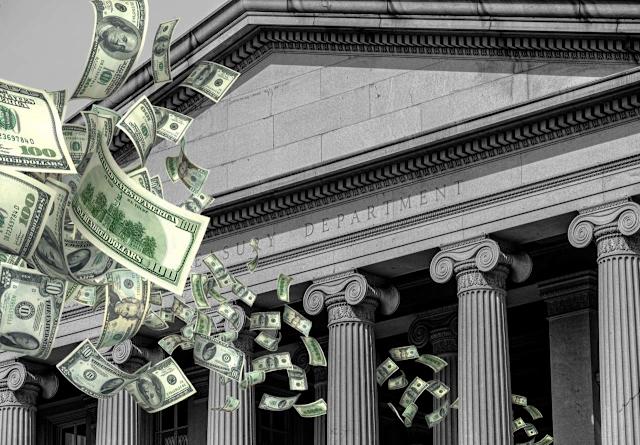Now that the megabill has passed, expect a ton of short-term debt to be sold to finance the government’s deficit

Bond-market participants were preparing as President Donald Trump’s massive plan for tax and spending cuts was signed into law, opening the floodgate to a deluge of short-term Treasury bills needed to finance the government’s deficit.
With Trump’s megabill clearing a in the House of Representatives on Thursday and getting the president’s signature Friday, the prospect of a surge in T-bills in what’s known as the very front end of the Treasury curve would test investor demand.
Most Read from MarketWatch
-
Now that the megabill has passed, expect a ton of short-term debt to be sold to finance the government’s deficit
-
‘I’m single’: At 70, I have $500,000 in stocks and $220,000 in savings. How do I invest my $130,000 windfall?
-
‘Today is my 61st birthday’: I have my ex-spouse’s Social Security benefits. Should I retire at 65 and travel?
-
‘I do all the yard work, cooking and cleaning’: I live with my daughter and her lazy boyfriend. She wants me to buy her house. Do I say yes?
-
My wife and I are in our late 60s. Do I sell stocks to pay our $30,000 credit-card debt — or do it gradually over 3 years?
Treasury bills are a kind of low-risk debt issued by the U.S. government that matures in a year or less. Yields on the debt have been climbing in recent days to above 4%.
Money-market investors have been one of the biggest groups thirsting for more of this asset to buy— helping to alleviate some concerns about whether more supply can easily be absorbed.
While the issuance of some Treasury bills would be cheaper for the government versus auctioning 10-year Treasurys at yields closer to 4.35%, the strategy isn’t without risks. Relying on short-term funding can expose a borrower to volatile or more expensive financing costs down the road.
“Anytime you are funding deficits with very short-term paper, there’s a risk that a shock could come along that puts that funding cost at risk,” said one bond portfolio manager based in Canada, who declined to be identified by name. If inflation suddenly rises and the Fed has to consider hiking rates, for example, that would increase the cost of short-term funding as yields on T-bills rise. In addition, a recession and contraction in economic activity could cause a drawdown in savings that reduces demand for short-term paper.
The nonpartisan Congressional Budget Office has estimated that Trump’s big bill of tax breaks and spending cuts could increase the national deficit by $3.4 trillion between 2025 and 2034, creating the need to finance the shortfall between government spending and revenue.
Trump has expressed a preference for issuing bills over bonds — a view that appeared to get some backing from Treasury Secretary Scott Bessent, who told Bloomberg Television earlier this week that it wouldn’t make sense for the government to boost sales of longer-term maturities. Treasury bills are regarded as cash equivalents and, since they mature in a year or less, are seen as relatively less risky than longer-dated notes and bonds
Anticipation over a deluge of T-bill supply that has the potential to bring a fresh round of volatility to the government’s shortest-term obligations marks a shift in focus for bond-market investors since earlier this year. In April and May, concerns about a rising federal deficit led to a sharp selloff in the 30-year bond BX:TMUBMUSD30Y, which sent its yield on a road above 5%.
Now, these concerns have been replaced by questions over whether there will be too much supply of Treasury bills and not enough demand, and how this might translate into T-bill rates. Such questions have contributed to a rise in the 1-month T-bill yield BX:TMUBMUSD01M seen since Monday.
On Thursday, everything from the 6-month BX:TMUBMUSD06M through 30-year yield BX:TMUBMUSD30Y jumped, largely in response to June’s better-than-expected official jobs report. Meanwhile, all three major U.S. stock indexes closed higher, with the S&P 500 SPX and Nasdaq Composite COMP recording fresh record highs. Thursday’s trading session was an abbreviated one, ahead of Friday’s Fourth of July holiday.
The Treasury Borrowing Advisory Committee, which advises the U.S. Treasury, has recommended that up to 20%, or roughly this level, of the government’s outstanding debt be in the form of T-bills, but this is now likely to go higher. At BofA Securities, rates strategists Meghan Swiber, Mark Cabana, and Katie Craig see the possibility that the supply of T-bills may reach up to 25% of marketable debt.
Matt Brill, head of North America investment grade credit at Invesco Fixed Income, told MarketWatch that “there has been a ton of demand for front end debt.” He also pointed to the $7 trillion in money-market funds, saying “there seems to be relentless demand for front-end debt,” and the Treasury Department seems to be aware of that.
Meanwhile, Mark Heppenstall, president and chief investment officer of Pennsylvania-based Penn Mutual Asset Management, said via phone on Thursday: “I don’t think the next crisis is coming from T-bills. There a lot of people who want to put capital to work and do that at real yields that look pretty darn attractive. You may see some sort of pressure on T-bill rates, but there’s still a lot of cash sloshing around. And if push comes to shove, the Fed will figure out a way to backstop any supply-demand imbalances.”
Joy Wiltermuth contributed.
Most Read from MarketWatch
-
My wife and I have $7,000 a month in pensions and Social Security, plus $140,000 cash. Can we afford to retire?
-
‘Finance makes me break out in hives’: I inherited $240K from my parents. Do I pay off my $258K mortgage and give up my job?
-
The Dow and Russell 2000 are joining the stock market’s party. Is it a game changer for the bulls?
-
My job is offering me a payout. Should I take a $61,000 lump sum — or $355 a month for life?
-
I’m a stay-at-home mom. Do I take a part-time job to spend more time with my kids — or get a job for six figures?
The passage of the massive bill signals a necessity for substantial short-term debt issuance to bridge government finances, reinforcing concerns over future budget sustainability and potential economic implications.
The passage of the megabill will inevitably lead to a surge in short-term debt sales, serving as an expedient measure for financing massive government deficits.
With the passage of this massive budget bill, anticipate a surge in short-term debt paper sales as efforts are made to fund government deficits.
The passing of the megabill signals a period where treasuries will witness an influx in short-term debt issuance as government attempts to finance its deficit, paving way for potential market volatility and interest rate adjustments.














